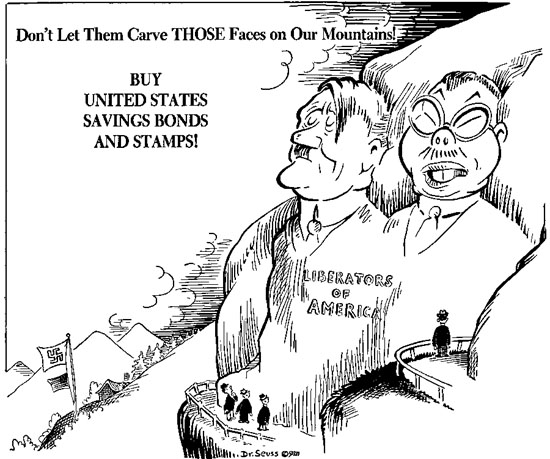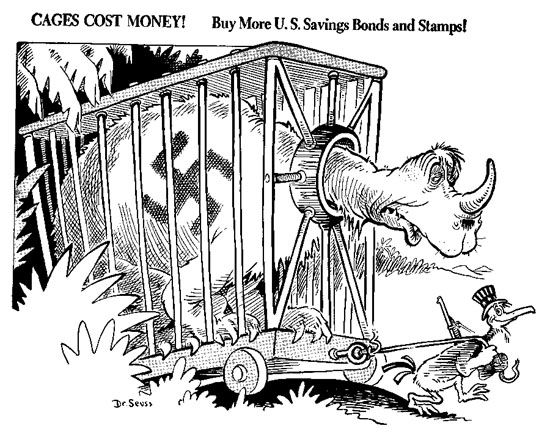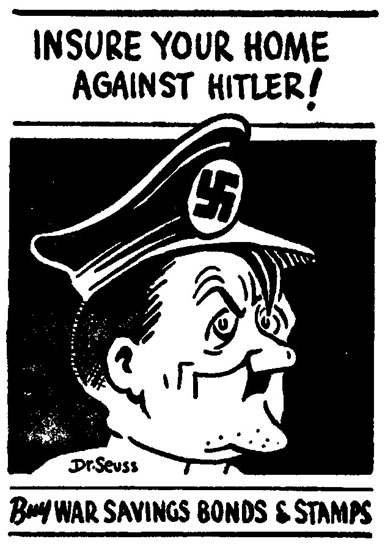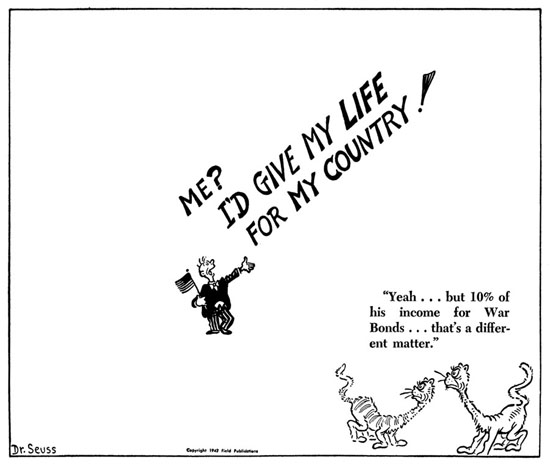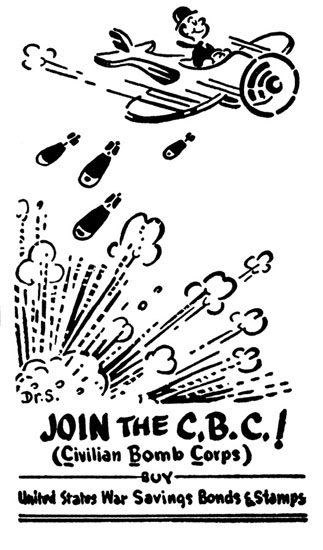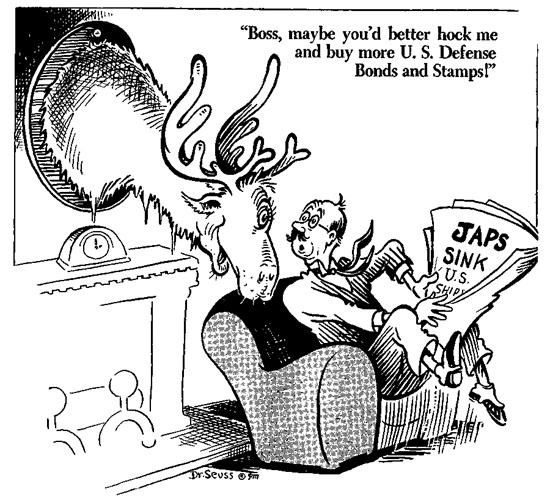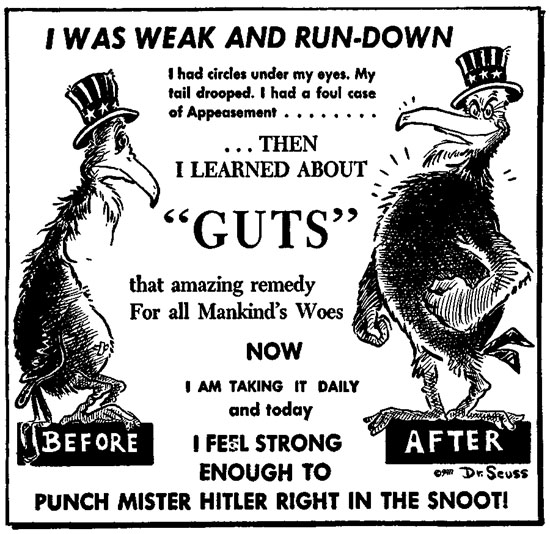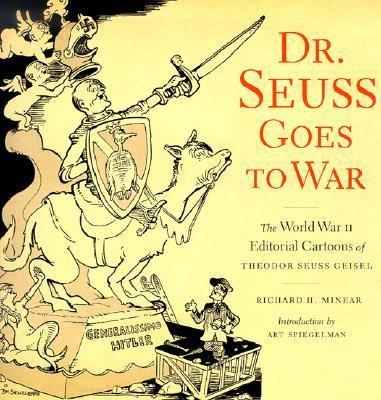Sam I Am Turns 50
This month in 1960, Random House published Dr. Seuss’s Green Eggs and Ham, a classic for kids of all agesIn 1960 Bennett Cerf, the famed editor of Random House, challenged one of his authors to write a book using 50 words or less. This didn’t seem like such a big deal to the author, one Theodor Seuss Geisel, who, as Dr. Seuss, had written a popular book titled The Cat In the Hat using only 225 words. Taking Cerf’s challenge, Dr. Seuss got to work, and 50 words later delivered Green Eggs and Ham. It was published this month, 50 years ago, in 1960, and is now the fourth best selling English language children’s book of all time.
The 50 words are: a, am, and, anywhere, are, be, boat, box, car, could, dark, do, eat, eggs, fox, goat, good, green, ham, here, house, I, if, in, let, like, may, me, mouse, not, on, or, rain, Sam, say, see, so, thank, that, the, them, there, they, train, tree, try, will, with, would, you.
Dr. Seuss’s Green Eggs and Ham, animated, voice of Sam and the neighbor by Paul Winchell, who was also the voice of Tigger in the Winnie Pooh cartoons.***
The Greater Lessons of Green Eggs and Ham
In his blog The Critical Path (Free Project Management Information, Advice, and Templates), Derek Huether, self-described "author and motivated project leader,” discovered the larger meaning of Dr. Seuss's Green Eggs and Ham while reading it to his son one night. Herewith, his revelations:
Last night I read Green Eggs and Ham to my son. Because nothing is sacred in my world of blogging and project management, I drew a parallel between Sam and myself.
If you don't know the story, Sam offers Green Eggs and Ham to an unnamed character. This character adamantly states he does not like them.
Sam looks for different opportunities and scenarios where the character may enjoy the green eggs and ham. Every time, he's dismissed. I will not eat them here or there. I will not eat them anywhere!
Still, Sam persists.
You do not like them. So you say. Try them! Try them! And you may. Try them and you may, I say.
The character finally laments and tries the green eggs and ham. Guess what? He likes them. He likes them a lot! All of a sudden, he realized all of the scenarios Sam recommended really are perfect opportunities to enjoy green eggs and ham.
So, what are green eggs and ham? I think they are ideas and opportunities. Yes, the same ones your colleagues had that got shot down. The same ones you had but were also dismissed. It's Agile, Scrum, Kanban, or some other approach the customer has never tried before, therefore, they don't even want to try it.
Next time someone has an idea or opportunity, try it! Try it! And you may. Deliver value in that way.
And here's an interesting response to Huether's revelations re: the Dr. Seuss classic:
Samad Aidane says:
March 12, 2010 at 9:37 am
Derek,This is a wonderful take on Dr. Seuss Green Eggs and Ham.
This reminds me of the classic challenges we project managers run into when some of our customers or users love the solution our project is delivering but some absolutely hate it. It puts us in a very tough position, especially when those who hate the solution are very vocal and never miss an opportunity to voice their strong feelings. This can sometimes impact the morale of the whole project team.
Then you fast forward a year later after the go live and the project is completed and you run into these same people and you hear from them that the solution is working for them and that everything is fine. You wonder what happened and where is the anger.
Now, they will never admit they like or, god forbid, they love it. Now try to take that same solution away from them or try to replace with another solution and see their reaction. They will threaten you life.
This just reminds us as project managers to expect resistance to change and have the capacity to cope with the conflict that results from some customers fighting change and fighting us to the end. When we are prepared for this, then conflict becomes a normal aspect of our projects. We develop a healthy relationship with conflict.
Too many times we get so excited about the solution we are delivering that our feelings can get easily hurt when others don't share our excitement. It is not easy when someone tells you "your baby is ugly.”
But we have to have the compassion for those who are not ready for change and don't share the same excitement about our solutions.I think compassion is the Project Manager's "Killer App.” It gives us the capacity to be patient with those who we have not walked in their shoes. And when they attack us personally, compassion will remind us that it is not us they are attacking. It is what we represent. And what we represent is change that can be scary to some. And some, that fear is real and can be as real as mortgage payments, children's college tuitions, and health insurance.
See more responses and other Derek Huether posts at http://thecriticalpath.info/2010/03/12/green-eggs-and-ham-are/
***
Dr. Seuss Goes To War
Dr. Seuss (Theodor Seuss Geisel, 1904-1991) was a life-long cartoonist: in high school in Springfield, Massachusetts; in college at Dartmouth (Class of 1925); as an ad man in New York City before World War II; in his many children's books, beginning with To Think That I Saw it on Mulberry Street (1937). Because of the fame of his children's books (and because we often misunderstand these books) and because his political cartoons have remained largely unknown, we do not think of Dr. Seuss as a political cartoonist. But for two years, 1941-1943, he was the chief editorial cartoonist for the New York newspaper PM (1940-1948), and for that journal he drew over 400 editorial cartoons.
The Dr. Seuss Collection in the Mandeville Special Collections Library at the University of California, San Diego, contains the original drawings and/or newspaper clippings of all of these cartoons. This website http://orpheus.ucsd.edu/speccoll/dspolitic/ makes these cartoons available to all Internet users. The cartoons have been scanned from the original newspaper clippings in the UCSD collection.
Dr. Seuss Goes to War by historian Richard H. Minear (The New Press, 1999) reproduced some two hundred of the PM cartoons. That means that two hundred of the cartoons available here have received no airing or study since their original appearance in PM. The cartoons Dr. Seuss published in other journals are even less known; there is no mention of them in Dr. Seuss Goes to War. Dr. Seuss also drew a set of war bonds "cartoons" which appeared in many newspapers as well as in PM.In Dr. Seuss & Mr. Geisel: A Biography (Random House, 1995; p 100), Judith and Neil Morgan recount the story of how Dr. Seuss and PM joined forces in 1941:
Ted [Dr. Seuss] was haunted by the war in Europe, and one evening in Manhattan he showed an editorial cartoon he had drawn to his friend Zinny Vanderlip Schoales, the brilliant, hard-drinking intellectual.... She had joined the patrician liberal Ralph Ingersoll when he launched the tabloid newspaper PM in New York with the backing of Marshall Field III. Zinny took Ted's cartoon to Ingersoll and PM published it on January 30, 1941...
A selection of Dr. Seuss’s PM editorial cartoons:
Although he spoke out against discrimination against African Americans and Jews (he even claimed he had been discriminated against in college in certain circles that believed him to be Jewish; in fact, he was a devout Lutheran), he was less charitable towards the Japanese, and especially towards Japanese Americans, whose internment during World War II he supported. In Richard H. Minear’s book Dr. Seuss Goes to War, Geisel is quoted thusly: “But right now, when the Japs are planting their hatchets in our skulls, it seems like a hell of a time for us to smile and warble ‘Brothers!’ It is a rather flabby battle cry. If we want to win, we’ve got to kill the Japs, whether it depresses John Haynes Holmes or not. We can get palsy-walsy afterward with those that are left.” (A prominent Unitarian minister and pacifist, John Hayne Holmes was mocked by Geisel in the latter’s PM cartoons.) Following the war, however, Geisel softened in his view of the Japanese, and expressed sympathy, in allegorical form, in his 1954 book, Horton Hears a Who, which he dedicated the book to “My Great Friend, Mitsugi Nakamura of Kyoto, Japan.” Minear, though, asserts the book is rife with American chauvinism, and points out its lack of any references to Hiroshima and Nagasaki.
THE BLUEGRASS SPECIAL
Founder/Publisher/Editor: David McGee
Contributing Editors: Billy Altman, Laura Fissinger, Christopher Hill, Derk Richardson
Logo Design: John Mendelsohn (www.johnmendelsohn.com)
Website Design: Kieran McGee (www.kieranmcgee.com)
Staff Photographers: Audrey Harrod (Louisville, KY; www.flickr.com/audreyharrod), Alicia Zappier (New York)
E-mail: thebluegrassspecial@gmail.com
Mailing Address: David McGee, 201 W. 85 St.—5B, New York, NY 10024
Founder/Publisher/Editor: David McGee
Contributing Editors: Billy Altman, Laura Fissinger, Christopher Hill, Derk Richardson
Logo Design: John Mendelsohn (www.johnmendelsohn.com)
Website Design: Kieran McGee (www.kieranmcgee.com)
Staff Photographers: Audrey Harrod (Louisville, KY; www.flickr.com/audreyharrod), Alicia Zappier (New York)
E-mail: thebluegrassspecial@gmail.com
Mailing Address: David McGee, 201 W. 85 St.—5B, New York, NY 10024





